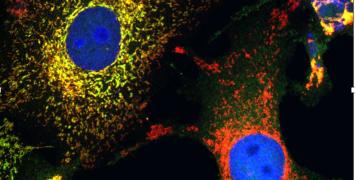Understanding acidification to fight infection
Prof. Giulio Superti-Furga and his team work on understanding the movement of molecules across human cells. In a paper recently published on Cell Host & Microbe, they outline the significance of a single protein, SLC4A7, in phagocytosis, the body's first line of defence against infection. These results, however, go beyond the context of infectious diseases, with repercussions on our knowledge of processes like inflammation and cancer.
In the arsenal of weapons our immune system uses to fight infection, macrophages are its field artillery. Found in every tissue, these cells recognise foreign bodies, like pathogens or harmful substances, and destroy them in a process known as phagocytosis. This is the first line of defence for the immune system. The macrophage engulfs its target and encloses it within vesicles known as phagosomes. Phagosomes then become progressively more and more acidic, breaking down the foreign object and eliminating the threat.
The process leading to this acidification is poorly understood, as it involves the movement of different nutrients and ions across the macrophage's membrane. The team of Giulio Superti-Furga, Scientific Director of the CeMM Research Center for Molecular Medicine of the Austrian Academy of Sciences, focused on "solute carriers" (SLCs), to try and explain how acidification in phagocytosis occurs. SLCs are the largest group of transporter proteins; responsible for the exchange of substances across cell membranes. As such, they seem like an ideal starting point to investigate phagocytosis.
The researchers developed special "impaired" cells using CRISPR/Cas9 technology. Each was unable to produce one of the 391 SLC proteins the team was studying. By observing how the cells performed during phagocytosis, the scientists were hoping to understand more about the function of missing SLCs. One specific protein, SLC4A7, a sodium bicarbonate transporter, appeared to be particularly significant, and cells that were unable to produce it could not acidify their phagosomes.
The team subsequently set to understand why this happened. As explained by Prof. Superti-Furga "SLC4A7 is located on the surface of macrophages and necessary for bicarbonate import from the environment into the cell". Bicarbonate is essential for regulating pH during phagocytosis. "If SLC4A7 was lost, the activation of macrophages led to the accumulation of protons in their cytoplasm, which further inhibited the acidification of phagosomes."
These results go beyond an insight into the functioning of an important immune mechanism. Since phagocytosis plays a part in other pathologic conditions, such as inflammation and cancer, the team's work has relevance outside the context of infectious diseases. Giulio Superti-Furga holds two ERC Advanced Grants, as well as two Proof of Concept grants. Since 2017, he is a member of the European Research Council's Scientific Council, the ERC's governing body.






